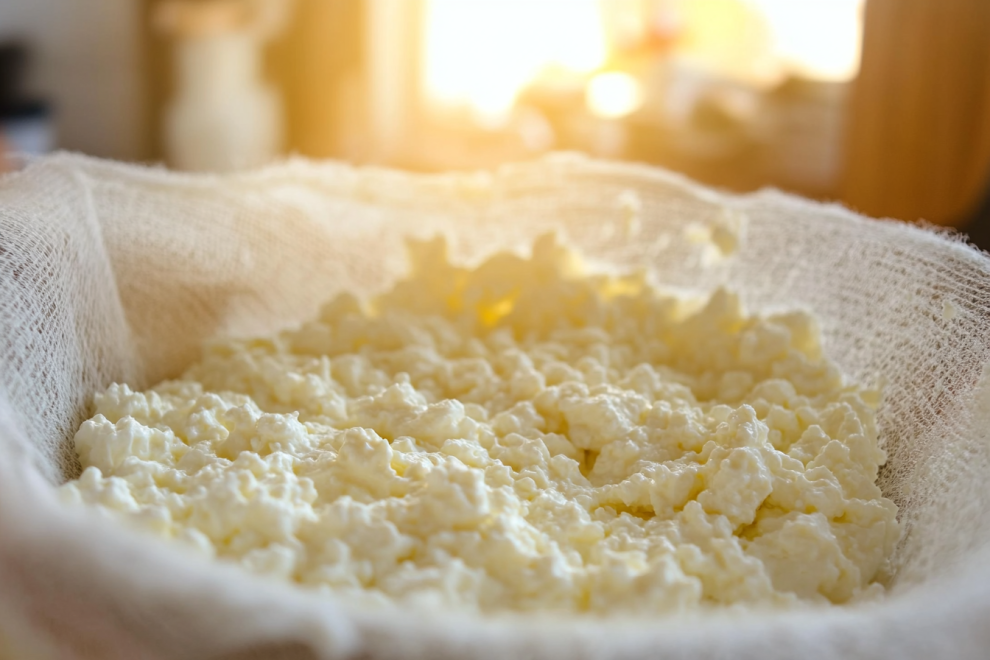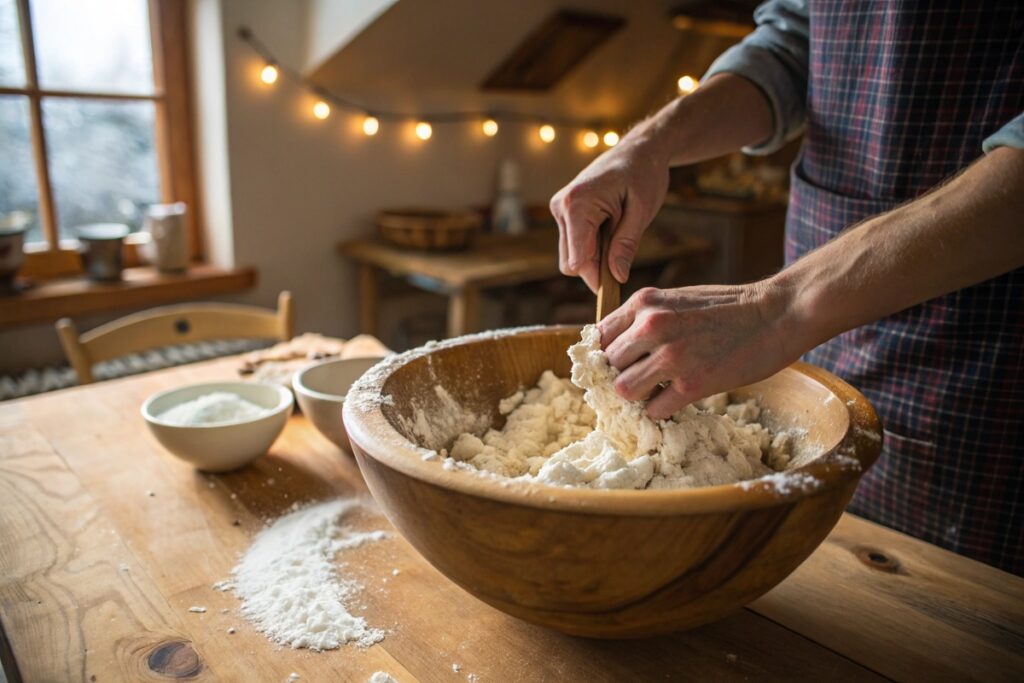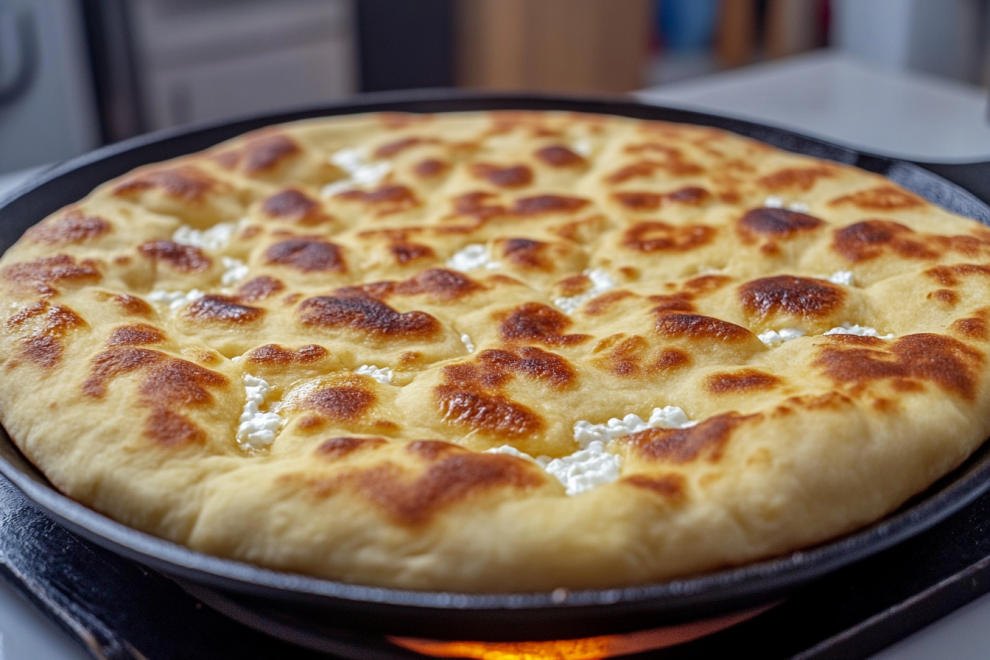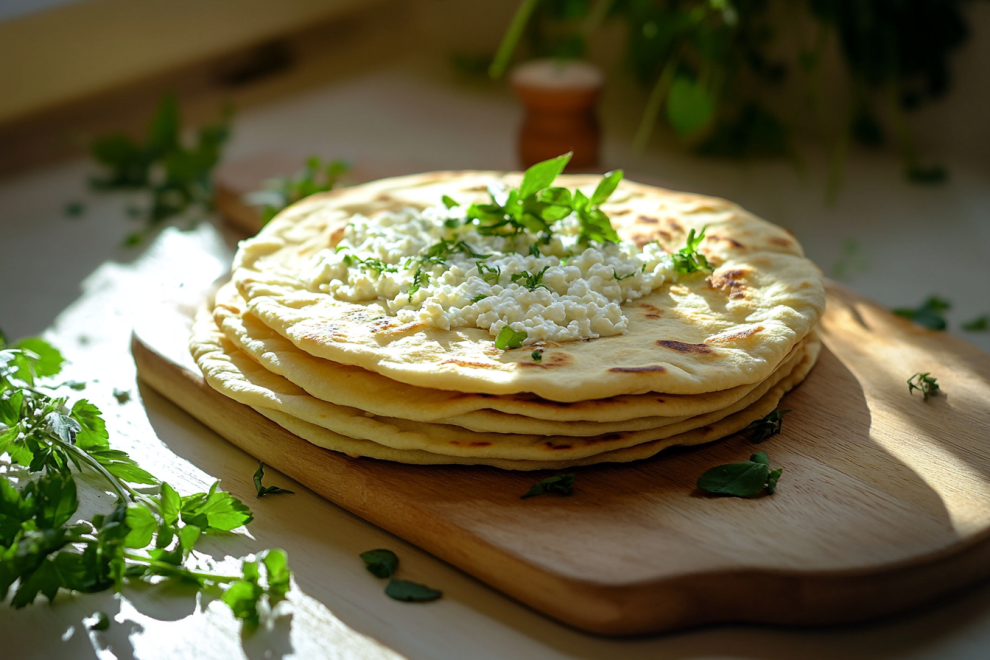Explore foolproof steps and top strategies to prevent cottage cheese flatbread from sticking, ensuring perfect results every time.
Introduction
If you have ever tried making cottage cheese flatbread at home, you know how frustrating it is when the dough clings stubbornly to your pan or baking surface. In many cases, home cooks struggle with too much moisture in the dough, insufficient flour, or a pan that’s simply not hot enough to keep everything from sticking. Therefore, learning how to keep cottage cheese flatbread from sticking is crucial if you want a beautifully golden-brown, tear-free result every time.
In this article, we will walk through the exact techniques for preventing your cottage cheese flatbread from sticking, including the importance of draining the cheese, achieving the ideal dough consistency, and selecting the right cooking method. Moreover, if you’re interested in exploring other savory ways to enjoy cottage cheese, be sure to check out our guide on Cottage Cheese in Scrambled Eggs for a protein-packed breakfast. For even more advice on balancing moisture levels, read our comprehensive tutorial on Why Is My Cottage Cheese Flatbread Soggy?.
By following the guidance below, you can discover how easy it is to make cottage cheese flatbread that stays intact, tastes delicious, and cooks consistently. Let’s dive deeper into the world of cottage cheese flatbreads and discover the best non-stick tips to guarantee a flawless outcome.

Table of Contents
Understanding the Cottage Cheese Flatbread Concept
Transition words are essential in making any cooking method clear and organized. Consequently, before focusing on how to stop cottage cheese flatbread from sticking, it’s important to understand what makes this particular flatbread unique.
What Sets Cottage Cheese Flatbread Apart?
First, cottage cheese flatbread stands out because cottage cheese contributes extra moisture, a tender crumb, and a protein boost. Many people enjoy this style of flatbread as a healthier alternative to regular bread. In addition, the slightly tangy flavor of cottage cheese adds complexity to your final product.
However, the high moisture content can cause problems. Specifically, if the cottage cheese has not been drained properly, your dough may stay too wet and attach itself to your cooking surface. To combat this, home cooks must learn proper draining methods, which we will discuss in detail later.
Nutritional Benefits of Cottage Cheese in Flatbread
Furthermore, cottage cheese is a great way to add protein and calcium to your meals. Compared to other cheeses, it often has fewer calories and less fat. Therefore, it can be an ideal choice if you’re looking to maintain a balanced diet without sacrificing flavor. Below is a quick look at some nutritional highlights of cottage cheese:
- High in protein: Helps keep you feeling full longer
- Rich in calcium: Supports bone health
- Low in fat options available: Ideal for those monitoring their calorie intake
Because these benefits are so appealing, cottage cheese flatbread has quickly become a popular go-to recipe for breakfast, lunch, or dinner.
Common Reasons Why Cottage Cheese Flatbread Sticks
To keep cottage cheese flatbread from sticking, we must first address the potential pitfalls. For example, excessive moisture, dough texture issues, cooking temperature, and subpar cooking surfaces all play a part.
Excessive Moisture in the Dough
Cottage cheese inherently contains a lot of liquid. Consequently, if you do not drain or press out some of the water, the dough can stay sticky. Additionally, humidity in your environment can exacerbate this issue, so always keep an eye on the dough consistency rather than relying on a one-size-fits-all recipe.
Imbalanced Dough Consistency
Too much flour will make your dough dry and crumbly, whereas too little flour leads to a sticky, hard-to-handle mess. Therefore, striking the right balance is critical. You want a dough that feels soft but not tacky, with enough elasticity to roll out smoothly.
Incorrect Heat or Cooking Method
Moreover, the temperature of your pan or oven can make or break the final outcome. If the surface isn’t hot enough, your flatbread dough may cling to the pan rather than forming a crisp crust. For this reason, always preheat thoroughly and adjust cooking time based on your heat source.
Unsuitable Cooking Surface
In addition, cooking surfaces such as stainless steel require more oil and careful heating to prevent sticking. Non-stick or well-seasoned cast iron skillets can sometimes be more forgiving. However, if the heat is not distributed evenly or if the skillet is not properly seasoned, sticking can still happen.
Essential Tools and Equipment
To consistently prevent cottage cheese flatbread from sticking, you need the right tools. Fortunately, you likely already have many of these in your kitchen.
Ideal Pans and Surfaces
- Non-Stick Pans: Their coating simplifies flipping and reduces adherence.
- Cast Iron Skillets: Once properly seasoned, they distribute heat evenly, which helps form a crust quickly.
- Ceramic Coated Pans: Provide a decent non-stick surface, though they can be more delicate.
Utensils for Easy Flipping
- Metal or Silicone Spatulas: Sturdy enough for flipping and scraping under your dough.
- Wooden Tools: Gentle on pan surfaces, but sometimes less effective at getting underneath sticky dough.
Preheating Your Surface
Because proper heat is essential, preheat your chosen cooking surface for a few minutes before placing the dough. Furthermore, add a small amount of oil only once the pan is hot to enhance the non-stick properties and prevent burning.
Preparing Ingredients the Right Way
Interestingly, ingredient preparation is the primary key to keep cottage cheese flatbread from sticking. The following steps ensure your dough is as manageable as possible.
Selecting Quality Cottage Cheese
First, look for fresh cottage cheese with minimal additives. Low-fat or full-fat varieties can both work, but you must be mindful of how the fat content might affect consistency. As a general rule, the creamier the cheese, the more water content it might carry.
Draining or Pressing Cottage Cheese
To minimize liquid:
- Cheesecloth Method: Place the cottage cheese in a cheesecloth and gently press to remove water.
- Strainer Method: Use a fine-mesh sieve and let the cheese sit for 20–30 minutes, occasionally pressing down with a spoon.
Through these steps, you can reduce excess moisture significantly and thus avoid overly wet dough.
Balancing Flour and Other Liquids
Once your cheese is well-drained, adding flour in small increments is the next priority. However, do not add it all at once. Instead, mix gradually, feeling the dough as you go. Use a bit of extra flour on your work surface to avoid further sticking but do not go overboard.
Effective Binders
If needed, binders like eggs or flaxseed help hold everything together. They also help achieve a less sticky dough. Yet, be cautious not to add too many wet ingredients; otherwise, you’ll end up undoing all your draining efforts.
Step-by-Step Recipe for Cottage Cheese Flatbread

Below is a detailed recipe that not only prevents sticking but also results in a delicious, nutrient-dense meal. Feel free to enjoy it for breakfast, lunch, or even as a quick dinner side.
Ingredients List
- 1 cup of cottage cheese (drained thoroughly)
- 1½ cups of all-purpose flour (plus extra for dusting)
- 1 large egg (optional, for extra binding)
- ¼ teaspoon of salt (adjust to taste)
- 1 teaspoon of baking powder (for a fluffier texture)
- 1 tablespoon of olive oil (for cooking, or any oil with a high smoke point)
Optional Flavor Add-Ons
- Chopped herbs (e.g., parsley, chives, or basil)
- Grated cheese for extra flavor (reduce salt if adding salty cheese)
- Garlic powder or onion powder for a savory twist
Expanded Step-by-Step Instructions
- Drain the Cottage Cheese:
Place your cottage cheese in a fine mesh strainer or cheesecloth. Press out as much water as possible. This step is critical if you want to stop cottage cheese flatbread from sticking later on. - Combine the Dry Ingredients:
In a large mixing bowl, whisk together the flour, salt, and baking powder. Incorporating these dry ingredients helps them disperse evenly. - Incorporate Cottage Cheese:
Transfer the drained cottage cheese into the bowl with the dry mix. Stir gently to start binding the dough. If using an egg, add it at this stage, mixing thoroughly. - Knead the Dough Gently:
Lightly flour your work surface, then knead the dough for about 2–3 minutes. Use additional flour if the dough is overly sticky, but add it sparingly. Overworking the dough can lead to a tough texture, so knead just until it holds together without sticking to your hands. - Rest the Dough (Optional):
Allowing the dough to rest for 10–15 minutes can improve elasticity and make rolling easier. - Shape the Flatbreads:
Divide the dough into equal portions (typically 4–6 pieces). Roll each portion into a circle about ¼ inch thick. Dust your rolling pin and surface lightly with flour to keep the dough from sticking. - Preheat Your Cooking Surface:
Heat a non-stick skillet or cast iron pan on medium. Once hot, add a small drizzle of oil or use a cooking spray. Allow the oil to heat for a few seconds. - Cook the Flatbreads:
Place one flatbread in the skillet. Cook for 2–3 minutes on each side, or until golden brown. Keep an eye on the heat to ensure it doesn’t burn or stick. - Cool and Serve:
Transfer cooked flatbreads to a plate lined with a clean towel. This helps keep them warm without trapping excess moisture underneath.
Nutritional Profile Per 100g
Below is a general estimate of the nutritional values for cottage cheese flatbread, assuming low-fat cottage cheese and minimal oil usage. Actual values may vary based on brand and specific ingredient choices.
| Nutrient | Approximate Amount |
|---|---|
| Calories | 150 kcal |
| Protein | 9 g |
| Fat | 3 g |
| Carbohydrates | 24 g |
| Calcium | 80 mg |
| Sodium | 180 mg |
| Fiber | 1 g |
Including these cottage cheese flatbreads in your routine can be a nice way to boost protein intake while still enjoying a comforting bread product.
Cooking Techniques to Prevent Sticking

After carefully prepping your dough and selecting the right tools, it’s essential to understand the best cooking methods to keep cottage cheese flatbread from sticking.
Pan Frying on the Stove
Most people choose a non-stick or cast iron skillet for pan-frying. Therefore, it’s vital to preheat the pan, use a light coating of oil, and cook each side at a moderate temperature. Too high of a heat can burn the outside while leaving the middle undercooked, potentially creating sticky dough pockets.
Baking in the Oven
Alternatively, you can bake cottage cheese flatbreads at around 375°F (190°C) for 8–10 minutes. In this case, always line your baking tray with parchment paper or a silicone mat to prevent the flatbreads from sticking. This method often yields an even bake and can be less hands-on than stove-top frying.
Using a Grill
Finally, you can grill cottage cheese flatbread outdoors for a smoky flavor. Be sure the grill grates are cleaned, lightly oiled, and preheated. In addition, it can help to place the flatbreads on a thin sheet of foil if you’re nervous about them sticking to the grates.
Preventive Measures and Techniques
Even with an ideal recipe, mistakes happen. Below are additional strategies to ensure your cottage cheese flatbread never sticks again.
Flour or Cornmeal Dusting
Sprinkling your workstation or the skillet with a bit of flour or cornmeal can create a barrier between the dough and hot surface. However, do this moderately to avoid a floury aftertaste.
Light Oil Application
Using a small amount of oil with a high smoke point (like avocado oil) can help reduce friction between the dough and pan. Nonetheless, too much oil can lead to greasy flatbreads.
Proper Flipping Technique
Wait until you see bubbles form and the edges look cooked before flipping. Then, use a wide spatula to slide underneath in a swift motion. This ensures you don’t tear the dough mid-flip.
Troubleshooting Sticky Cottage Cheese Flatbread
Although we’ve outlined the fundamentals, real-life cooking doesn’t always go as planned. Therefore, these troubleshooting tips can help you adapt on the fly.
Mid-Cooking Adjustments
- If dough remains sticky: Sprinkle a little more flour on top and around the edges.
- If the pan is too hot: Lower the temperature to avoid burning the exterior while the interior remains undercooked.
Consistency Fixes
- Adding small amounts of water: If your dough feels too dry, a teaspoon at a time can make it more pliable.
- Adding extra binder: An additional half egg or a spoonful of ground flaxseed (mixed with water) can salvage dough that simply refuses to hold its shape.
Serving Suggestions and Variations
You’ve finally mastered how to keep cottage cheese flatbread from sticking. Now, let’s explore how you might serve it.
- Accompany Soups and Stews: For instance, dip into hearty vegetable soup or chili.
- Make Mini Pizzas: Top each flatbread with tomato sauce, mozzarella, and veggies, then bake briefly.
- Use as a Wrap Substitute: Fill your cottage cheese flatbread with grilled chicken, salad greens, and a drizzle of sauce for a healthier wrap option.
FAQ Section
Below are some common questions people have when trying to stop cottage cheese flatbread from sticking.
How to remove water from cottage cheese?
Draining cottage cheese is simple. First, line a strainer or sieve with cheesecloth and spoon the cottage cheese onto it. Next, place the strainer over a bowl and let it sit for about 20–30 minutes. Finally, gently press the cheese with a spoon or the back of a measuring cup to release excess moisture. If you don’t have cheesecloth, a fine-mesh sieve or even a clean kitchen towel can work just as well.
Is flatbread dough meant to be sticky?
It can be slightly tacky, but it should not be so sticky that it clings to your hands or your cooking surface. Cottage cheese flatbread dough often feels softer than standard bread dough due to the moisture content of the cheese. However, through proper draining and careful flour addition, the dough should become workable without adhering to everything.
How long can you store cottage cheese flatbread?
Generally, cooked cottage cheese flatbread stays fresh for about 2–3 days when wrapped in foil or placed in an airtight container at room temperature. If you want longer storage, keep them in the refrigerator for up to 5 days, or freeze for up to 1 month. Always reheat flatbreads on a skillet or in the oven to restore their texture.
How to get over the texture of cottage cheese?
If you find the texture of cottage cheese off-putting, blending it slightly can help. You can also choose cottage cheese brands that offer smaller curds. When baked or cooked into the dough, the curds typically melt and distribute throughout, so the final product tastes more like a mild, cheesy bread rather than traditional cottage cheese.
Conclusion
In summary, learning how to keep cottage cheese flatbread from sticking revolves around a few key principles. It’s essential to drain the cottage cheese thoroughly, balance the flour-to-moisture ratio, and use the right heat and cooking surface. Moreover, flipping technique and ensuring the skillet or oven is properly preheated will further minimize any sticking issues.
Therefore, by following these steps and tips, you’ll master the art of making non-stick cottage cheese flatbread that turns out consistently delicious. Above all, practice will help you refine your approach, so don’t be afraid to experiment with new flavors and techniques. With enough practice, you’ll be serving up perfectly cooked, protein-rich cottage cheese flatbreads that stay intact, taste fantastic, and never cling stubbornly to your pan again.

